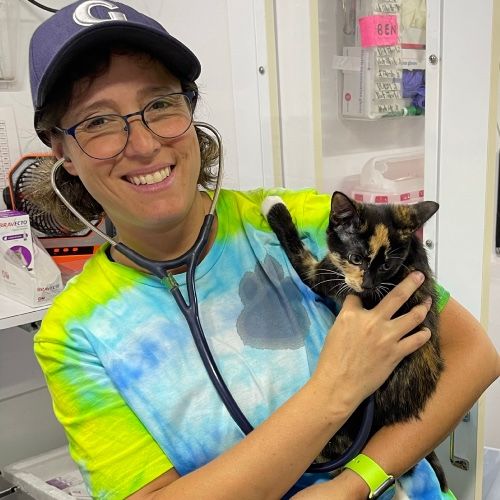Animal ForensiCon 2025: Diagnostic Imaging of Thoracic Trauma with Federico Grosso, DVM
Dr. Federico Grosso, Clinical Associate Professor of Diagnostic Imaging at the University of Florida College of Veterinary Medicine, discusses the importance of x-rays in diagnosing the cause and consequences of trauma to the chest.
The 2025 Animal ForensiCon: The Animal Forensic Investigations Conference is a three-day event, offered in Daytona Beach Shores, Florida from May 7th to 9th, 2025. The conference is hosted by the University of Florida’s Veterinary Forensic Sciences Laboratory.
ForensiCon offers workshops and educational sessions on a wide variety of topics pertaining to criminal investigations, law, small animal investigations, equine and livestock investigations, and wildlife crimes. This conference is open to anyone interested in animal forensic investigations. Attendees will also have the opportunity to network with faculty, experts, and investigators
Transcript
All right, so just came out of a really great presentation
2
:and I have here with me Dr.
3
:Federico Grosso, that is gonna talk to us
a bit about his presentation, which was
4
:on diagnostic imaging of thoracic trauma.
5
:Right.
6
:Thank you so much for being here.
7
:Federico Grosso: No, thank you so much.
8
:For sure.
9
:So, uh, this is my pleasure to be here
in this, uh, podcast and, uh, I just
10
:came out from lecturing about thoracic
trauma and, uh, injuries to the neck.
11
:So it's a subject that I think is
very, uh, important for people working
12
:with forensics and as animal welfare.
13
:Especially for alive patients
because I was not talking a lot
14
:about a postmortem imaging indeed.
15
:But, uh, how to recognize the most
severe lesions and then, uh, how
16
:to recognize those radiographs.
17
:And then certainly when you
identify these type of lesions,
18
:then what to do after that.
19
:Which ones are really life threatening
for the patient and needs to be
20
:addressed very fast, and which others
they are like, not so important that
21
:can be addressed later on, like limb
fractures, stuff like that, that can
22
:certainly have surgery in a later time.
23
:However, some of the lesion that we
have been talking today that there are
24
:really a problem or more life-threatening
conditions will be pneumothorax in
25
:case of, uh, trauma, either, which
is blunt trauma or penetrating
26
:trauma, where we have gas going from
the outside into the pleural space.
27
:And the problem of this condition is that
that will cause retraction of the lungs.
28
:That will not allow the lungs to
be expanded, and then when they're
29
:not expanding is gonna decrease the
oxygenation, then certainly that
30
:could be the problem for the patient.
31
:And that's something that needs to
be treated very fast if it's severe.
32
:And in those cases, they either, they will
do what we call a thoracentesis that is
33
:a puncture of the chest just to remove
all these gaps from the pleural space
34
:or maybe just even placing a chest tube.
35
:So a tube preventing the pleural space
to keep on moving and removing that.
36
:Specifically from pneumothorax,
there is one of them that is even
37
:more life-threatening, which we
call the tension pneumothorax or
38
:the hypertensive pneumothorax.
39
:And, uh, in this case, what is gonna
happen is that, as I don't have gas
40
:in the pleural space, the injury in
the lung is gonna have a valve effect,
41
:and then every time the patient is
inspirating, then there will be more gas
42
:entering each time in the pleural space.
43
:Aggravating the compression,
the retraction of the lungs,
44
:and certainly compromising the
respiration very fast in that patient.
45
:So this type of pneumothorax
is the most aggressive that
46
:needs to be treated immediately.
47
:If not, you will lose
probably the patient.
48
:DrG: And it, and I guess it's
important to know what it, what
49
:we're seeing as far as treatment, but
then also based on the pathology, we
50
:can have an idea of what caused it.
51
:Right?
52
:Like what kind of trauma would cause it.
53
:Federico Grosso: Yes.
54
:So every time when we look at the
radiograph, depending what are the
55
:findings, which is changes in the
subcutis, uh, surrounding the, the
56
:chest, we can be thinking more about it.
57
:Or if we have wounds about a penetrating
trauma, either with an object, either with
58
:an animal that attacked another animal.
59
:And then if your changes is
coming mostly from the inside to
60
:the outside, then we're gonna be
thinking mostly about blunt trauma.
61
:And I would say vehicular trauma is the
most common that we see with these cases.
62
:Sometimes they can be also kicked
by a human, kicked by another
63
:animal, something like that.
64
:But in those cases, then likely you're
gonna see solutions more in the chest
65
:rather than outside of the chest.
66
:DrG: Recently, I had a case where
the, the story was that the animal
67
:died from strangulation, but the
witnesses said that the animal likely
68
:died from being kicked in the abdomen.
69
:And the findings during necropsy
were no injuries to the trachea and
70
:chest, and the dog had liver tears.
71
:So can the diagnostics not only
help find out what happened, but
72
:also rule out what didn't happen?
73
:Federico Grosso: Yes.
74
:That's a great question.
75
:And in this case, certainly.
76
:By obtaining just thoracic radiographs,
they could have determined if it was
77
:truly an strangulation case or not.
78
:Because in case of a strangulation
or choking, we know that they're
79
:gonna develop non cardiogenic
pulmonary edema and that has a very
80
:specific distribution in the lungs,
which loosely starts caudo-dorsally
81
:symmetrically or assymmetrically.
82
:So in that dog, if they would
have taken a thoracic radiographs.
83
:They will have seen that the lungs
probably they're completely normal.
84
:However, they would have seen abdominal
distention, decreased peritoneal
85
:detail or loss of serosal peritoneal
detail, likely compatible then with
86
:hemorrhage and a lot of effusion.
87
:DrG: I also, I believe that, as
veterinarians we are shown how
88
:to evaluate thoracic radiographs.
89
:But like I was telling you a little
bit earlier, like I myself find it
90
:difficult to look at radiographs.
91
:So what is the importance of
having a radiologist review
92
:the radiographs that we do?
93
:Federico Grosso: That's a good question.
94
:I would say certainly I'm gonna favorize
my market, but, but I would say that, uh.
95
:If, um, I mean if you feel confident
reading your radiographs, then
96
:probably you would not need to
send that for a telemedicine or
97
:have a radiologist next to you.
98
:But certainly if you work in a big
practice where you have radiologist
99
:in situ, in the same place, that
will be certainly the best tool
100
:because then you can go directly
talk to them, consult of the cases.
101
:So that would be ideal.
102
:The problem is that radiologists
they're not so, uh, available now and
103
:a lot of them they do to telemedicine.
104
:So, uh, is a huge amount of practices
and hospital that they don't have access
105
:to a radiologist in situ and in person.
106
:So, uh, I would say depends on the case,
but certainly if you need consultation
107
:and you don't have a radiologist
next to you and you use telemedicine,
108
:should be some type of telemedicine
that provides you the option for STAT
109
:cases and to get them very, very fast.
110
:Because in the light of trauma and
especially the clinical complaints
111
:of the dogs, that your bad, then
you need to know what's going on
112
:fast if you're not sure about it.
113
:If the patient is stable, then
certainly you can submit that to
114
:telemedicine and then wait hours,
one day because that's gonna be okay.
115
:But uh, if the patient is not
breathing okay or something like
116
:that, then certainly you need
to have a consultation fast.
117
:DrG: Excellent.
118
:Well, thank you so very much.
119
:Your lecture was amazing, your images were
great, and you know, thank you so much for
120
:your time and thank you for being here.
121
:Federico Grosso: Thank you so much.
122
:It's been a pleasure and, uh,
enjoying a little bit of Daytona.

